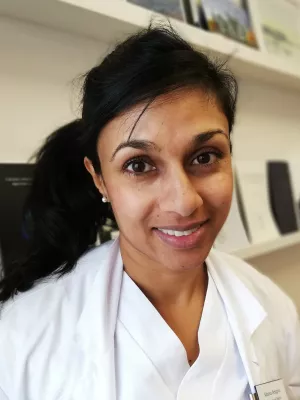
Johanna Vennström Berggren
Doctoral student

The effect of traction force on eyelid blood perfusion during closure of defects
Author
Summary, in English
Purpose
In oculoplastic surgery the eyelid tissue is frequently stretched in order to repair defects after tumor surgery. However, there is a paucity of research regarding how stretching affects eyelids. The purpose of this study was to gain insight into how traction force affects eyelid stretch as well as tissue perfusion, using a laser-based in vivo monitoring technique.
Method
Lower-lid pentagonal resections were performed in eight patients and a total of nine eyelids. The medial section of the eyelid was then stretched using a dynamometer up to a force of 2.3 Newtons (N), and eyelid stretching and blood perfusion were continuously measured using laser speckle contrast imaging.
Results
Tissue perfusion decreased exponentially when eyelid tissue was stretched, with an initial sharp decline followed by a more gradual reduction. Perfusion approached zero at a force of approximately 2.0 N. The length of the eyelid increased with increasing force up to 1.5 N, after which there was only a very slight increase in length.
Conclusions
Eyelid tissue seems to respond to traction in a non-linear fashion, where the initial force results in the greatest eyelid stretching and reduction in blood perfusion. The results provide information on the effects of a large force for direct closure of large eyelid defects. Considering how quickly perfusion approaches zero, the high success rate of eyelid reconstruction surgery is likely a testament to the extensive vascularization of the periocular region.
In oculoplastic surgery the eyelid tissue is frequently stretched in order to repair defects after tumor surgery. However, there is a paucity of research regarding how stretching affects eyelids. The purpose of this study was to gain insight into how traction force affects eyelid stretch as well as tissue perfusion, using a laser-based in vivo monitoring technique.
Method
Lower-lid pentagonal resections were performed in eight patients and a total of nine eyelids. The medial section of the eyelid was then stretched using a dynamometer up to a force of 2.3 Newtons (N), and eyelid stretching and blood perfusion were continuously measured using laser speckle contrast imaging.
Results
Tissue perfusion decreased exponentially when eyelid tissue was stretched, with an initial sharp decline followed by a more gradual reduction. Perfusion approached zero at a force of approximately 2.0 N. The length of the eyelid increased with increasing force up to 1.5 N, after which there was only a very slight increase in length.
Conclusions
Eyelid tissue seems to respond to traction in a non-linear fashion, where the initial force results in the greatest eyelid stretching and reduction in blood perfusion. The results provide information on the effects of a large force for direct closure of large eyelid defects. Considering how quickly perfusion approaches zero, the high success rate of eyelid reconstruction surgery is likely a testament to the extensive vascularization of the periocular region.
Department/s
- Ophthalmology, Lund
- Ophthalmology Imaging Research Group
- Teachers at the Medical Programme
- LU Profile Area: Light and Materials
- LTH Profile Area: Photon Science and Technology
- Clinical and experimental lung transplantation
- NPWT technology
Publishing year
2024-04-30
Language
English
Publication/Series
Orbit (London)
Document type
Journal article
Publisher
Informa Healthcare
Topic
- Ophthalmology
Status
Epub
Research group
- Ophthalmology Imaging Research Group
- Clinical and experimental lung transplantation
- NPWT technology
ISBN/ISSN/Other
- ISSN: 0167-6830

